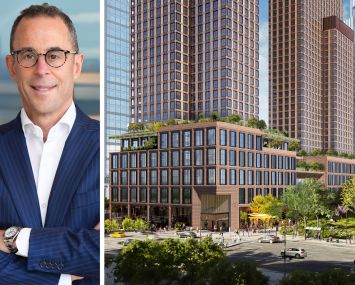Meatpacking District-Chelsea Twofer Aims to Become Bid No. 70
By Lauren Elkies Schram February 19, 2014 1:00 pm
reprints

Is there a clear-cut line between southern Chelsea and the Meatpacking District now that both are no longer gritty?
Not really, says a committee that is trying to launch a new Business Improvement District called Meatpacking Area BID that would treat the two areas as one in order to provide maintenance, development and promotional services.
Besides, the people who established and manage the two organizations that maintain the Meatpacking District and southern Chelsea—the Meatpacking District Improvement Association (MPIA) and Chelsea Improvement Company (CIC)—are one and the same.
“It really is one physical area that looks alike, that acts alike,” said Paul Pariser, the co-chief executive officer of Taconic Investment Partners. He is also the BID steering committee chair and the founder of MPIA and CIC. “The world perceives that that Meatpacking District runs into south Chelsea and into the West Village a bit.” For example, he said, “Chelsea Market is the most Meatpacking-y building in the district.” Then there’s Google at 111 Eighth Avenue, he noted, which will say it’s in the Meatpacking District but is really a block outside of the historic neighborhood.
The BID boundaries would be 17th Street to the north, the northern half of Horatio Street to the south, 10th or 11th Avenue to the west and Hudson Street or Eighth Avenue to the east.
Mr. Pariser noted that merging the boards is logistically sound.
“Why have a redundancy?” he said.
A BID confers a permanent and capital status. Rather than the two organizations being funded by contributions, a BID would require a special assessment to be paid by property owners.
Lauren Danziger, the executive director of MPIA, noted that having a steady income stream would allow for the expansion and addition of services in the areas of sanitation, beautification, public safety and traffic mitigation. And more services will be necessary as big commercial developments like Piers 54 and 57, as well as the Whitney Museum of American Art, emerge and foot traffic increases.
“There is a free rider issue here,” Ms. Danziger said, as there is not 100 percent financial participation from tenants. “This is an equitable solution.”
The proposed BID has a $1.6 million budget, based on all ground-floor commercial property owners paying 22 cents per square foot for their entire building. It is likely that commercial landlords will pass that cost onto their tenants. Residential property owners would pay a token $1.
Richard Skulnik, the executive vice president and partner at Ripco Real Estate, a firm that leases out property on Gansevoort and 13th Streets, said the amount being requested isn’t a big deal.
“Twenty-two cents a foot isn’t dramatic,” Mr. Skulnik said. “If you had 10,000 square feet, you’re at $2,200 a year. That’s $180 a month. For the tenants that can afford to be in Meatpacking, that should be a nominal charge—that’s if it’s passed down.”
The BID committee is slated to go before the local community boards, 2 and 4, next month. The legislative phase, which includes hearings by the community boards, City Planning Commission and City Council and the mayor’s signature, typically takes about nine months, according to a spokesperson for Small Business Services, which is tasked with managing the city’s relationships with each of the current 69 BIDs and ensuring BIDs carry out services.
There appears to be widespread support for the new BID.
“We are very bullish on Meatpacking, and we believe that the district should be a little more cohesive,” said Marc Watkins, the executive vice president of DelShah Capital, which owns 55-61 Gansevoort Street, 69 Gansevoort Street and 58-60 Ninth Avenue. “I think there should be an annual budget that handles some of the services … that would help increase the value of the shopping experience.”
Mr. Watkins thinks the area could have a more coherent footprint, better oversight for foot traffic and clearer signage for pedestrians.
“I think a business improvement district would firm up and create something more cohesive with more marketing,” he said, and it could “bring in bigger tenants.”
Thomas Nakios, the owner of Lilla P, a 400-square-foot ground-floor retail shop at 420 West 14th Street and a resident on Hudson Street at 13th Street, is a proponent of the BID. Mr. Nakios, who was recently asked to join the BID Steering Committee, said the Meatpacking District and southern Chelsea are already one neighborhood and that the 22-cent fee was nominal, especially since he contributes more than that now.
The BID Steering Committee is comprised of commercial and residential property owners and tenants, including representatives from the Standard, Soho House New York, the Whitney, Google, Jamestown Properties and the Meilman Family Real Estate.
Members of both boards have been mulling a merger for a number of years, Mr. Pariser said, and this past June, they formally approved moving forward with BID exploration. The boards fell under the same management as of February 1.
Retail specialist Faith Hope Consolo, a broker at Douglas Elliman, said, “Meatpacking and Chelsea are so closely intertwined it makes sense for them to unify to support each other and ensure that their businesses thrive.”
The combining of abutting organizations under one roof is not new.
In Downtown Brooklyn, the Downtown Brooklyn Partnership brought the MetroTech BID, the Fulton Mall Improvement Association and the Court-Livingston-Schermerhorn BID under one roof.
“We manage them all,” said Tucker Reed, the president of the Downtown Brooklyn Partnership. “We get huge economies in terms of both a management and cost savings—being able to operate as one as opposed to three disparate districts. The most important point in all that is our customer base—the people that are coming to these areas. They’ve got no cognition of when they’re in [one BID or the other]. All they know is they’re having a good time or they’re not having a good time.”


